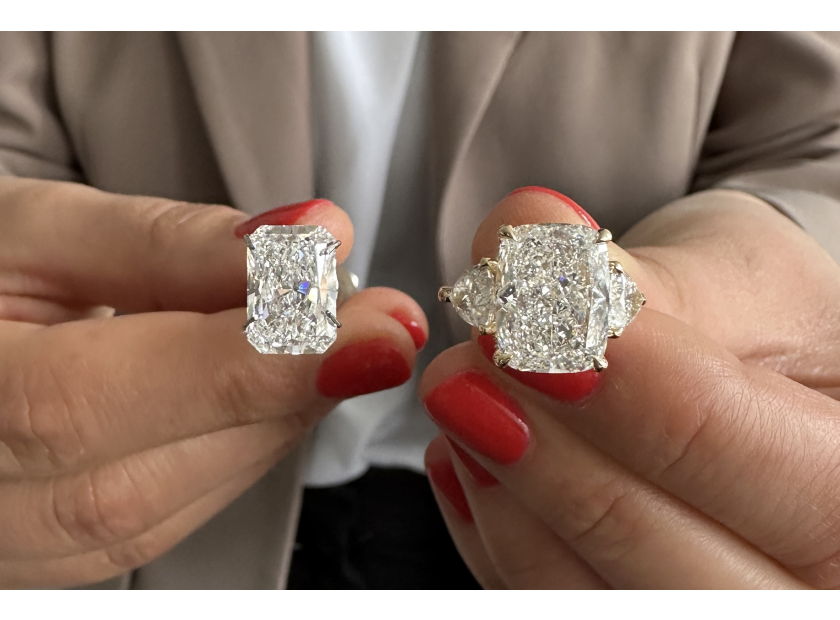USD
/
USD
/
Shipping to:
Currency:
Why Lab-Grown Diamonds Are Better for the Environment
The world is shifting toward sustainability, and with it comes a growing demand for ethical and eco-friendly alternatives in all aspects of life—including jewelry.
Diamonds, a timeless symbol of love and commitment, have traditionally been associated with natural mining, a process often riddled with environmental and ethical challenges.
Enter lab-grown diamonds, a revolutionary option that combines beauty and brilliance with sustainability.
Let’s explore why lab-grown diamonds are truly better for the environment and why they’re becoming the go-to choice for conscientious consumers.
What Are Lab-Grown Diamonds?
Lab-grown diamonds, as the name suggests, are created in controlled laboratory environments using advanced technology that replicates the natural diamond formation process.
Two primary methods—Chemical Vapor Deposition (CVD) and High Pressure High Temperature (HPHT)—allow scientists to grow diamonds that are chemically, physically, and optically identical to those mined from the earth.
What sets them apart isn’t their composition but the way they’re sourced.
Unlike natural diamonds, lab-grown options don’t require invasive mining operations, making them a more sustainable and ethical choice for modern shoppers.
If you’re interested in exploring options, you can check out lab-grown diamonds to find a variety of shapes and sizes.
The Environmental Impact of Natural Diamond Mining
Diamond mining has long been criticised for its detrimental effects on the planet.
The process involves massive land displacement, resource consumption, and waste generation.
Here are some of the most significant environmental concerns:
- Land Degradation: Mining often involves clearing forests and disrupting ecosystems, leaving scars on the landscape that can take decades—or even centuries—to recover.
- Water Pollution: The chemicals and sediments released during mining contaminate nearby water sources, affecting both aquatic life and local communities.
- Carbon Footprint: Mining operations are energy-intensive, relying on heavy machinery and fossil fuels that contribute to greenhouse gas emissions.
- Waste Generation: For every carat of diamond extracted, vast amounts of earth are displaced, creating enormous waste piles that further damage the environment.
For an eco-friendly alternative, explore fancy colored lab-grown diamonds that offer unique hues without the environmental toll of mining.
How Lab-Grown Diamonds Help the Environment
Lab-grown diamonds offer a way to enjoy the timeless allure of diamonds without the environmental toll.
Here’s how they stand out:
- Preserving Natural Landscapes: Since lab-grown diamonds don’t require mining, they save ecosystems from destruction and keep forests intact.
- Lower Carbon Emissions: Studies show that lab-grown diamonds have a significantly smaller carbon footprint compared to their mined counterparts. This is especially true when renewable energy sources are used in production.
- Water Conservation: Producing lab-grown diamonds uses far less water than traditional mining, helping conserve one of the planet’s most precious resources.
- Minimal Waste: The production process generates very little waste, especially compared to the mountains of debris left behind by mining operations.
If you’re looking for classic styles, round lab-grown diamonds are a timeless option that marries sustainability with elegance.
The Role of Renewable Energy and Technological Advancements
Many leading lab-grown diamond manufacturers are turning to renewable energy sources to further reduce their environmental impact.
Solar, wind, and hydroelectric power are being integrated into production facilities, creating a more sustainable cycle.
Additionally, advancements in technology are making the lab-grown process more energy-efficient over time.
With ongoing innovation, lab-grown diamonds are set to become an even greener option.
Explore cutting-edge styles like oval lab-grown diamonds for a modern yet sustainable choice.
Beyond Sustainability: Ethical Advantages of Lab-Grown Diamonds
Lab-grown diamonds don’t just benefit the planet—they also address critical ethical issues associated with natural diamond mining.
- Avoiding Conflict Zones: Lab-grown diamonds eliminate the risk of supporting unethical practices, such as conflict or blood diamonds that fund armed violence.
- Reducing Social Disruption: Mining often displaces local communities, disrupts livelihoods, and leads to poor working conditions. Lab-grown diamonds bypass these issues entirely.
- Supporting Global Sustainability Goals: By choosing lab-grown diamonds, consumers contribute to global efforts aimed at reducing environmental degradation and promoting ethical practices.
For a bold statement, consider cushion lab-grown diamonds, which offer a vintage-inspired yet ethically sourced look.
Challenges and Progress in Lab-Grown Sustainability
While lab-grown diamonds are a more sustainable choice, there’s room for improvement.
Some critics point to the energy required for production, particularly if facilities rely on non-renewable power sources.
However, many companies are working toward carbon-neutral operations and cleaner energy solutions, ensuring that lab-grown diamonds continue to evolve as an environmentally friendly option.
If you love unique shapes, pear lab-grown diamonds offer a distinctive blend of modernity and grace.
Spotlight on Sustainable Brands
Several companies are leading the way in creating eco-friendly lab-grown diamonds.
By investing in renewable energy and prioritizing sustainable practices, these brands demonstrate that luxury and responsibility can go hand in hand.
For consumers, choosing lab-grown diamonds is a powerful way to support these efforts while making a statement about their values.
Want something extraordinary? Check out radiant lab-grown diamonds for their brilliant sparkle.
Conclusion
Lab-grown diamonds are reshaping the jewelry industry by offering a sustainable, ethical, and beautiful alternative to mined diamonds.
They preserve ecosystems, reduce carbon footprints, and eliminate the environmental and social costs of mining.
By choosing lab-grown diamonds, you’re not just investing in a stunning piece of jewelry—you’re making a meaningful contribution to the health of the planet.
It’s a small but impactful step toward a more sustainable future.
FAQs
-
Are lab-grown diamonds eco-friendly?
-
Yes, lab-grown diamonds are significantly more eco-friendly than mined diamonds. They require less land, water, and energy while producing minimal waste.
-
How do lab-grown diamonds impact climate change?
-
Lab-grown diamonds have a much lower carbon footprint compared to mined diamonds. Some manufacturers are even achieving carbon neutrality by using renewable energy.
-
What makes lab-grown diamonds a sustainable alternative?
-
Lab-grown diamonds eliminate the need for mining, which damages ecosystems, consumes vast resources, and generates waste. Their production is far gentler on the planet.
-
Can lab-grown diamonds truly replace mined diamonds?
-
Absolutely. Lab-grown diamonds are chemically, physically, and visually identical to mined diamonds. They offer the same sparkle and durability without the environmental or ethical concerns.
-
What should I look for when buying a lab-grown diamond to ensure it’s sustainable?
-
Look for brands that prioritize renewable energy and have certifications for sustainable practices. Transparency about the production process is also a good indicator.








